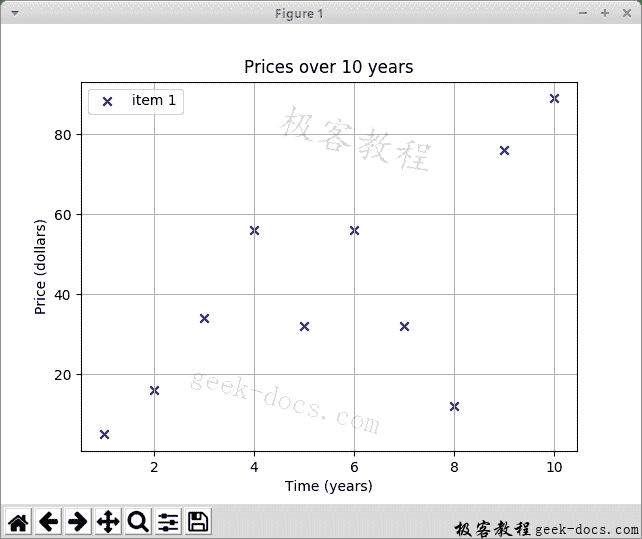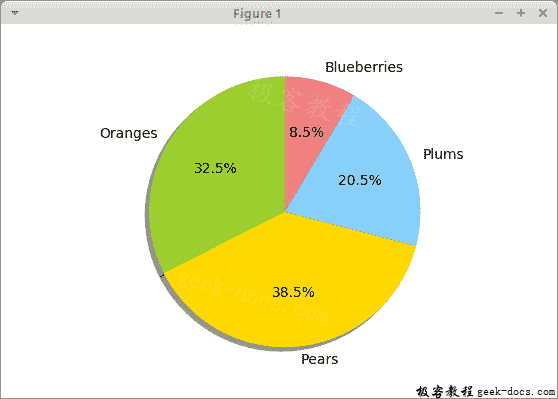| Matplotlib 教程 | 您所在的位置:网站首页 › matplotlib怎么安装 › Matplotlib 教程 |
Matplotlib 教程
|
Matplotlib 教程展示了如何使用 Matplotlib 在 Python 中创建图表。 我们创建散点图,折线图,条形图和饼图。 文章目录 1 Matplotlib2 Matplotlib 安装3 Matplotlib 散点图4 两个数据集5 Matplotlib 折线图6 Matplotlib 条形图7 Matplotlib 饼图 MatplotlibMatplotlib 是用于创建图表的 Python 库。 Matplotlib 可用于 Python 脚本,Python 和 IPython shell,jupyter 笔记本,Web 应用服务器以及四个图形用户界面工具包。 Matplotlib 安装Matplotlib 是需要安装的外部 Python 库。 $ sudo pip install matplotlib我们可以使用pip工具安装该库。 Matplotlib 散点图散点图是一种图形或数学图,使用笛卡尔坐标显示一组数据的两个变量的值。 scatter.py #!/usr/bin/python3 import matplotlib.pyplot as plt x_axis = [1, 2, 3, 4, 5, 6, 7, 8, 9, 10] y_axis = [5, 16, 34, 56, 32, 56, 32, 12, 76, 89] plt.title("Prices over 10 years") plt.scatter(x_axis, y_axis, color='darkblue', marker='x', label="item 1") plt.xlabel("Time (years)") plt.ylabel("Price (dollars)") plt.grid(True) plt.legend() plt.show()该示例绘制了一个散点图。 该图表显示了十年内某些商品的价格。 import matplotlib.pyplot as plt我们从matplotlib模块导入pyplot。 它是创建图表的命令样式函数的集合。 它的操作与 MATLAB 类似。 x_axis = [1, 2, 3, 4, 5, 6, 7, 8, 9, 10] y_axis = [5, 16, 34, 56, 32, 56, 32, 12, 76, 89]我们有 x 和 y 轴的数据。 plt.title("Prices over 10 years")通过title()功能,我们可以为图表设置标题。 plt.scatter(x_axis, y_axis, color='darkblue', marker='x', label="item 1")scatter()功能绘制散点图。 它接受 x 和 y 轴,标记的颜色,标记的形状和标签的数据。 plt.xlabel("Time (years)") plt.ylabel("Price (dollars)")我们为轴设置标签。 plt.grid(True)我们用grid()功能显示网格。 网格由许多垂直和水平线组成。 plt.legend()legend()功能在轴上放置图例。 plt.show()show()功能显示图表。
在下一个示例中,我们将另一个数据集添加到图表。 scatter2.py #!/usr/bin/python3 import matplotlib.pyplot as plt x_axis1 = [1, 2, 3, 4, 5, 6, 7, 8, 9, 10] y_axis1 = [5, 16, 34, 56, 32, 56, 32, 12, 76, 89] x_axis2 = [1, 2, 3, 4, 5, 6, 7, 8, 9, 10] y_axis2 = [53, 6, 46, 36, 15, 64, 73, 25, 82, 9] plt.title("Prices over 10 years") plt.scatter(x_axis1, y_axis1, color='darkblue', marker='x', label="item 1") plt.scatter(x_axis2, y_axis2, color='darkred', marker='x', label="item 2") plt.xlabel("Time (years)") plt.ylabel("Price (dollars)") plt.grid(True) plt.legend() plt.show()该图表显示两个数据集。 我们通过标记的颜色来区分它们。 x_axis1 = [1, 2, 3, 4, 5, 6, 7, 8, 9, 10] y_axis1 = [5, 16, 34, 56, 32, 56, 32, 12, 76, 89] x_axis2 = [1, 2, 3, 4, 5, 6, 7, 8, 9, 10] y_axis2 = [53, 6, 46, 36, 15, 64, 73, 25, 82, 9]我们有两个数据集。 plt.scatter(x_axis1, y_axis1, color='darkblue', marker='x', label="item 1") plt.scatter(x_axis2, y_axis2, color='darkred', marker='x', label="item 2")我们为每个集合调用scatter()函数。 Matplotlib 折线图折线图是一种显示图表的图表,该信息显示为一系列数据点,这些数据点通过直线段相连,称为标记。 linechart.py #!/usr/bin/python3 import numpy as np import matplotlib.pyplot as plt t = np.arange(0.0, 3.0, 0.01) s = np.sin(2.5 * np.pi * t) plt.plot(t, s) plt.xlabel('time (s)') plt.ylabel('voltage (mV)') plt.title('Sine Wave') plt.grid(True) plt.show()该示例显示正弦波折线图。 import numpy as np在示例中,我们还需要numpy模块。 t = np.arange(0.0, 3.0, 0.01)arange()函数返回给定间隔内的均匀间隔的值列表。 s = np.sin(2.5 * np.pi * t)我们获得数据的sin()值。 plt.plot(t, s)我们使用plot()功能绘制折线图。 Matplotlib 条形图条形图显示带有矩形条的分组数据,其长度与它们代表的值成比例。 条形图可以垂直或水平绘制。 barchart.py #!/usr/bin/python3 from matplotlib import pyplot as plt from matplotlib import style style.use('ggplot') x = [0, 1, 2, 3, 4, 5] y = [46, 38, 29, 22, 13, 11] fig, ax = plt.subplots() ax.bar(x, y, align='center') ax.set_title('Olympic Gold medals in London') ax.set_ylabel('Gold medals') ax.set_xlabel('Countries') ax.set_xticks(x) ax.set_xticklabels(("USA", "China", "UK", "Russia", "South Korea", "Germany")) plt.show()该示例绘制了条形图。 它显示了 2012 年伦敦每个国家/地区的奥运金牌数量。 style.use('ggplot')可以使用预定义的样式。 fig, ax = plt.subplots()subplots()函数返回图形和轴对象。 ax.bar(x, y, align='center')使用bar()功能生成条形图。 ax.set_xticks(x) ax.set_xticklabels(("USA", "China", "UK", "Russia", "South Korea", "Germany"))我们为 x 轴设置国家/地区名称。 Matplotlib 饼图饼图是圆形图,将其分成多个切片以说明数值比例。 piechart.py #!/usr/bin/python3 import matplotlib.pyplot as plt labels = ['Oranges', 'Pears', 'Plums', 'Blueberries'] quantity = [38, 45, 24, 10] colors = ['yellowgreen', 'gold', 'lightskyblue', 'lightcoral'] plt.pie(quantity, labels=labels, colors=colors, autopct='%1.1f%%', shadow=True, startangle=90) plt.axis('equal') plt.show()该示例创建一个饼图。 labels = ['Oranges', 'Pears', 'Plums', 'Blueberries'] quantity = [38, 45, 24, 10]我们有标签和相应的数量。 colors = ['yellowgreen', 'gold', 'lightskyblue', 'lightcoral']我们为饼图的切片定义颜色。 plt.pie(quantity, labels=labels, colors=colors, autopct='%1.1f%%', shadow=True, startangle=90)饼图是通过pie()功能生成的。 autopct负责在图表的楔形图中显示百分比。 plt.axis('equal')我们设置了相等的长宽比,以便将饼图绘制为圆形。
Figure: Pie chart 在本教程中,我们使用 Matplotlib 库创建了散点图,折线图,条形图和饼图。 您可能也对以下相关教程感兴趣: PrettyTable 教程,SymPy 教程,Python 教程。 |
【本文地址】

